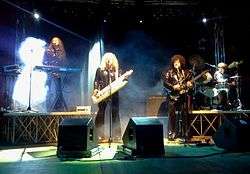Cugini di campagna
Cugini di campagna is an Italian pop band formed in 1970 in Rome. They are referred to in the plural as I cugini di campagna. The band is well known for the use of falsetto and for their eccentric look, a cross between glam and kitsch.[1]
Cugini di campagna | |
|---|---|
 | |
| Background information | |
| Origin | Rome, Italy |
| Genres | Dance-pop, easy listening, pop rock |
| Years active | 1970–present / |
| Website | www |
| Members | Nicolò Pibiri Michele Bonassi Luca Storelli |
| Past members | Nicolò Pibiri Michele Bonassi Paul Manners Marco Occhetti |
Background
The band achieved some success with its first single, "Il ballo di Peppe", that was launched by the radio-program Alto Gradimento.[2] In 1973 the band gained more success with the song "Anima mia", then they achieved a series of commercial hits until the early eighties.[1][3] After a difficult period the band resurfaced in 1997, with a new lineup, thanks to the RAI TV-show Anima mia, whose success lead to the rediscovery of their eponymous song and band;[2] from then Cugini produced a series of albums, containing both re-arranged versions of their earlier hits as well as new songs.
Personnel
Current members
- Ivano Michetti (from 1970)
- Silvano Michetti (from 1970)
- Tiziano Leonardi (from 2012)
- Daniel Colangeli (from 2015)
Former members
- Flavio Paulin (1970-1977)
- Gianni Fiori (1970-1972)
- Giorgio Brandi (1973-1996)
- Paul Manners (1978-1985)
- Marco Occhetti, aka Kim (1986-1990)
- Luca Storelli (1997-2011)
- Nick Luciani (1994-2014)
Discography
- Selected singles
- 1970 - "Il ballo di Peppe"
- 1972 - "Un letto e una coperta/L'uva è nera"
- 1973 - "Anima mia"
- 1973 - "Solo Con Te"
- 1974 - "Innamorata"
- 1974 - "Un'altra donna"
- 1975 - "64 anni"
- 1975 - "Preghiera"
- 1976 - "È lei"
- 1977 - "Conchiglia bianca"
- 1977 - "Tu sei tu/Donna"
- 1978 - "Dentro l'anima"
- 1979 - "Meravigliosamente"
- 1980 - "No tu no"
- 1981 - "Valeria"
- 1982 - "Uomo miov
- 1985 - "Che cavolo d'amore"
- 1998 - "Amor Mio"
- 2002 - "Vita della mia Vita"
- 2006 - "Sapessi quanto"
- 2011 - "Mi manchi tu"
References
- Enrico Deregibus. Dizionario completo della Canzone Italiana. Giunti Editore, 2010. ISBN 8809756258.
- Ezio Guaitamacchi. 1000 canzoni che ci hanno cambiato la vita. Rizzoli, 2009. ISBN 8817033928.
- Dario Salvatori. Storia dell'Hit parade. Gremese, 1989. ISBN 8876054391.